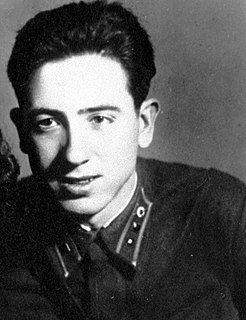
The title Hero of the Soviet Union was the highest distinction in the Soviet Union, awarded together with the Order of Lenin personally or collectively for heroic feats in service to the Soviet state and society.

Hazi Aslanov was an Azerbaijani major-general of the Soviet armoured troops during World War II. He was awarded the Hero of the Soviet Union title twice. The second Hero title was posthumously awarded on July 12, 1991, by Mikhail Gorbachev, at the constant recommendations by Heydar Aliyev.

The Internal Troops, full name Internal Troops of the Ministry for Internal Affairs (MVD), alternatively translated as "Interior ", is a paramilitary gendarmerie-like force mostly in succession states of the Soviet Union and in other countries as well, including in Russia, Ukraine, Georgia, Kazakhstan, Kyrgyzstan, Azerbaijan, Belarus, Turkmenistan, Tajikistan and Uzbekistan. It is also maintained as reserve forces in the Armed Forces of Mongolia. Internal Troops are subordinated to the interior ministries of the respective countries.

The 1961 Kurenivka mudslide occurred on 13 March 1961 in Kyiv, then a city in the Ukrainian SSR, Soviet Union. The mudslide started at the edge of the Babi Yar mass murder site and dumped mud, water, and human remains into the streets of Kyiv. The Soviet authorities suppressed information about the disaster, and claimed 145 people were killed, while forbidding any memorial events for the victims. A 2012 study in Ukraine estimated that the number of victims was closer to 1,500.

The 51st Guards Mechanized Brigade was a formation of the Ukrainian Ground Forces, stationed at Volodymyr in Volyn Oblast, on the border with Poland. The Brigade drew its history from the 51st Guards Rifle Division, which was formed from the 76th Rifle Division midway through the Second World War. In late 1942, the 76th Rifle Division decimated the German force holding and protecting Kletskaya, a key industrial city with numerous metal works factories. For it, the division was promoted to Guards status on November 23, 1942, and became known as the 51st Guards Rifle Division.

The 3rd Cavalry Division "Principe Amedeo Duca d'Aosta" was a Cavalry or "Celere" (Fast) division of the Royal Italian Army during World War II. The division was formed in 1934, and during World War II was mobilized in June 1940. As a cavalry division it took part in the Invasion of Yugoslavia and was part of the Italian Expeditionary Corps in Russia. Annihilated during the Red Army's Operation Little Saturn in December 1942, the survivors returned to Italy in spring 1943.
The 12th Guards Uman Orders of Lenin Red Banner and Suvorov Tank Division was a tank division of the Soviet Ground Forces. It drew its history from the World War II 16th Tank Corps. It was redesignated successively as 12th Guards Tank Corps (1943) and 12th Guards Tank Division (1946).

Rubén Ruiz Ibárruri was a Spanish military officer and Soviet commander of the 100th Machine Gun Company of an independent training battalion of the 35th guards rifle division of the 62nd army of the Stalingrad Front. He was posthumously awarded the rank of captain of the Guards unit, and also 2 times the Order of the Red Banner. By the decree of the Supreme Soviet of the USSR, he was posthumously awarded the title of Hero of the Soviet Union. He was posthumously awarded the Order of Lenin. He was a Lieutenant of the International Brigade during the Spanish Civil War. The asteroid 2423 Ibarruri was named in his honour at 1972. He died in the Battle of Stalingrad.
The 10th Rifle Division 'Stalingrad' of the Order of Lenin of the Internal Troops of the NKVD of the USSR was a Soviet rifle division formed on 1 February 1942 prior to the Battle of Stalingrad during the Great Patriotic War and participated in heavy front-line actions which would significantly reduce its strength by the battle's end. It was under the jurisdiction of the Internal Troops of the NKVD but took strategic orders from the 62nd Army command. Later it converted into a regular Red Army division and was renamed the 181st "Order of Lenin" "Stalingrad" Rifle Division.
The 95th Rifle Division was a Red Army Rifle Division during World War II, formed three times. The division was first formed in November 1923 with the 6th Rifle Corps. It fought in the Winter War and the Soviet occupation of Bessarabia and Northern Bukovina. After Operation Barbarossa, the division fought in the retreat from Moldova and fought in the siege of Odessa and the siege of Sevastopol. It was destroyed during the siege of Sevastopol and was disbanded in late July 1942. The division was reformed in August 1942 from the 13th Motor Rifle Division NKVD and fought at the Battle of Stalingrad. For its actions during the battle, the division became the 75th Guards Rifle Division in March 1943. In April 1943, the division was formed a third time at Kaluga from the 121st Rifle Brigade. It fought in Operation Bagration.
The 181st Rifle Division was a division of the Red Army, active from 1940 to at least 1945, formed from the remnants of the Latvian Army after the Soviet occupation of Latvia in 1940.
The 140th Rifle Division was a Red Army rifle division that saw service during the Great Patriotic War. Originally formed during the prewar buildup of the Red Army, the 140th might be regarded as the unluckiest division in the Army, as it, uniquely, had to be completely, or almost completely, re-formed three times between 1941 and 1943, being destroyed in the Uman pocket during Operation Barbarossa, the Vyasma pocket during Operation Typhoon, and on the Caucasian steppes in the face of the German summer offensive of 1942. In spite of this, the fourth formation of the 140th went on to have a very distinguished record in combat, a testament to the resiliency of the Red Army in World War II.
The 8th Motorized Rifle Division of the NKVD Internal Troops was formed in accordance with NKVD Order Number 0021 from January 5, 1942, during execution GKO decree number 1099- ss on January 4, 1942. It was based on the 23rd Motorized Rifle Division NKVD Internal Troops.

Habibullah Huseynov was an Iranian Azerbaijani Red Army colonel and a posthumous Hero of the Soviet Union. Huseynov emigrated to Baku, working as a loader and a fitter. He was drafted into the Red Army on a Komsomol direction in 1928 and became an artillery officer. He was arrested and imprisoned as an Iranian spy during the Great Purge. He was released months later and became an anti-aircraft artillery battalion commander, serving in this role during World War II.

Ilya Arkhipovich Vlasenko was a political commissar in the Red Army during and following World War II. Vlasenko was awarded the title Hero of the Soviet Union in 1943 for his leadership in the Battle of the Dnieper.
The 2nd Guards Anti-Aircraft Artillery Division was an anti-aircraft artillery division of the Soviet Union's Red Army during World War II and the Soviet Army during the early years of the Cold War.
The 4th Anti-Aircraft Artillery Division was an anti-aircraft artillery division of the Soviet Union's Red Army during World War II and the Soviet Army in the early postwar years.
The 212th Airborne Brigade was an airborne brigade of the Soviet Airborne Troops, formed twice.

Ivan Prokofievich Sivakov was a Red Army major general and a posthumous Hero of the Soviet Union.

Galiy Adilbekovich Adilbekov – was a Soviet career officer-tanker, participant of the Great Patriotic War, master of tank combat, Kazakh, Guards unit lieutenant colonel, awarded: the Medal "For the Defence of Stalingrad" (1943), twice the Order of the Red Banner ( 02/13/1942), the second – posthumously (1943). Killed in battle during the liberation of Kyiv.











